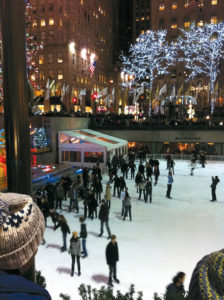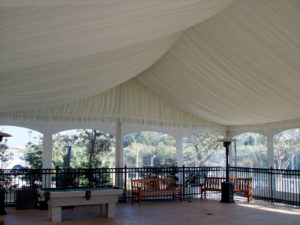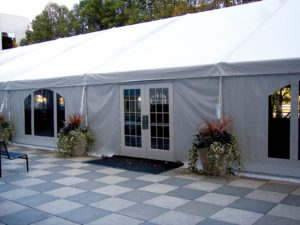
Tented events take place in all kinds of weather, upping the demand for doors and specialty sidewalls.
The popularity of tented events can be attributed, at least in part, to the human desire to be outdoors. However, this doesn’t mean that people actually want to experience being outside. Instead, they want the panoramic vistas while still being protected from less desirable elements such as heat, cold, wind, rain and assorted insects.
This paradox has led to a growing demand for high-end finishes, such as doors and sidewalls, that add elegance to tented events while keeping the fun in and nature out. Contributing to the clamor for these products is the fact that the tent season continues to march across the calendar into months where, formerly, the thought of holding an outdoor event was, well, unthinkable.
“These seasonal effects are why tent doors, hard walls and glass walls are on the rise in popularity,” says Biff Gentsch, national sales manager for Anchor Industries Inc., Evansville, Ind.
An improving economy and a trend toward tents themselves becoming star players in the event world have inspired upgrades and the more liberal use of accessories; momentum that builds as these items receive greater exposure. But tent rental businesses considering adding doors or specialty sidewalls to their inventories need to move somewhat cautiously, because these items can represent a sizable investment, particularly for smaller operations.

Sidewall: Options galore
“Sidewalls are a staple of a tented event, but with that comes inherent complexities driven by the end users,” says Bryan Bolt, sales manager for TopTec Event Tents, Moore, S.C.
“Window styles, closure systems, materials and other items make it tough to have all varieties of walls in stock for immediate demand,” Bolt says. “There are so many variables that, outside of very basic solid or cathedral window walls, many are made to order, which involves longer lead times.”
There’s no shortage of options. For example, Anchor offers inflatable sidewalls (RigidAir®), as well as those designed to solve the eave-to-wall connection issue with sailcloth-style tents (WeatherShield®). Rainier Industries, a Tukwila, Wash.-based manufacturer, also offers inflatable sidewalls as well as the Power Wall, a motorized fabric sidewall adapted from the company’s commercial shade and awning unit.
The beauty of inflatable sidewalls is that the walls become very tight, creating an effective barrier against the outside, which preserves the tent’s interior climate control, says Dan Dunstan, regional sales manager
for Rainier.

The Navi-Trac Lite® Pavilion from Anchor is a portable, semi-permanent, single-slope awning tent that easily attaches to an existing structure. Here, sidewall and tent top windows provide an unobstructed view of New York City’s Rockefeller Center. Photo courtesy of Party Line Rentals, Elmsford, N.Y., and Anchor Industries.
Fabric sidewalls can range from solid, reinforced vinyl rectangles with various styles of hooks at the tops and connectors on the sides, to more sophisticated versions, Dunstan says. They can come with different styles of clear vinyl windows and in a myriad of fabrics, from standard white to almost every color of coated fabrics, to clear panels or window shapes made from marine-grade products, to mesh fabrics.
“Vinyl sidewalls can also be manufactured with rigid, polycarbonate panels,” Dunstan says. “The primary benefit is that the windows are nearly clear, almost like a glass pane, allowing for improved outside views.”
The addition of roller wheels and keder edges comprise the biggest advancement in sidewall design, says Scott Sutherland, president of Tacoma, Wash.-based Olympic Tent.
“When we first offered an eave tube with track for wheels and keder legs, some clients were slow to recognize the benefits,” Sutherland says. “Today, 90 percent of our clients are sliding into the legs and rolling the walls open and closed, typically with a zippered enclosure.”
During warm weather, the roller wheel walls can be left open, swagged to the legs, Sutherland explains. If the weather cools, the walls can easily be closed, without the rental company having to return to hang the walls.
Some manufacturers also offer clear or solid sidewalls made from various rigid materials, most often plastic, Dunstan says. “These are often designed to fit a specific tent or structure and create a very sealed and interior-like environment.”
Although soft walls have traditionally been comparatively faster to install, today’s hard wall systems go in about as quickly, Bolt says. However, they’re not for every tent, such as pole tents or many of the smaller frame tents.
What to consider stocking? Bolt says athletic events frequently ask for hard walls. Ben Hall, president of Advantage Tent Fittings Inc., Chillicothe, Ohio, suggests if you’re targeting weddings, sidewalls with decorative windows might be a good addition; for fairs and festivals, lighter-weight, solid sidewalls are a good choice. Mesh sidewalls might reap good sales for tent rental companies situated in warmer climates, Hall says, while heavier-duty, blockout vinyl works well for those in areas with high winds.

Doors: Do your homework
Doors offer increased control over the interior environment, reducing heating and cooling costs. This makes doors almost “a necessary evil” for many smaller rental outfits in particular, says Sutherland. Why that description?
“They’re expensive, difficult to handle with big heavy crates, and the amount of rent they can collect barely covers this,” he explains. “But for larger rental companies in bigger markets that can charge more, they’re a nice add-on to the sale.”
As is the case with sidewalls, there are plenty of choices. For example, Anchor offers three different styles: the Ambassadoor®, the Ambassadoor Lite® and the Commodoor®. “We have a door for every application and price range,” says Gentsch. “All three feature aluminum frames and stainless hardware to minimize corrosion and weight.” Both Ambassadoor models are glass doors; the Commodoor uses lightweight vinyl.

legs from TopTec Event Tents was a long-term installation
at an event facility. The tent features French double doors
and cathedral-style windows set into vinyl sidewalls. Photo courtesy of TopTec Event Tents.
Rainier’s Fibertech door system incorporates a steel frame that bolts together and doesn’t rack, along with fiberglass doors and tempered glass inserts. A lighter-duty, less expensive system that shares many similar features is also available.
Before committing to any door, tent rental companies should do their homework, says Sutherland. “Doors can be challenging if they choose one that’s difficult to install. Talk to as many rental companies as possible to find out which doors to avoid. Once they make a purchase, I suggest training a door specialist to ensure the installation process always goes smoothly.”
Sutherland suggests asking:
- How hard is the door to install?
- Will the door swell over time in wet or humid climates?
- Does it have easy adjustments for ground that’s not level?
- Does the manufacturer stock the door (and in what quantities?) or is it made to order?
- If custom, what lead time is recommended?

Adding inventory
For both doors and sidewalls, rental companies should consider the compatibility with their existing inventory, as well as transportability and durability, says Bolt. Codes and regulations may also factor into the purchasing decision.
Look for products that help differentiate you from your competitors, says Gentsch. At the same time, think about how frequently the new item might be rented per year and to what kinds of customers. If uncertain but still tempted, subrenting might be the way to go until you get a better sense of utilization.
“However, if you’re confident you can move the product six or more times annually, you’re likely to find a few more rentals other than what you’ve already booked,” Gentsch says. “In this case, it probably makes good sense to purchase the product.”

Bolt advises small and medium-sized rental companies to standardize their inventories as much as possible. “Try not to be everything to everyone if it doesn’t fit with the growth plan of the company,” he says. “For example, it may be good to have one set of doors complemented with some vinyl walls featuring zippered openings instead of biting the bullet on multiple sets of doors.
“Finding long-term rentals is another way of building inventory on these accessories,” Bolt continues. “This lets the end user pay for that inventory in the initial rental, so it’s free and clear when it comes back to the rental company.”
Pamela Mills-Senn is a Long Beach, Calif.-based freelance writer.
As clients demand one-of-a-kind events, designers consider how every element within the space will contribute to the experience.
Even tent poles are getting scrutinized. There’s no reason that they can’t add to the beauty of an event, even as they’re performing a utilitarian purpose. Advantage Tent Fittings Inc., Chillicothe, Ohio, offers
a line of engineered wooden tent poles that complement the trendy rustic theme.
And their appeal isn’t limited to just this decor style.
“The major benefit of wooden tent poles, aside from their sheer beauty, is that unlike aluminum poles, a few scratches here or there adds character over time to the product as it undergoes a natural seasoning process,” says company president Ben Hall. Hall adds that the poles were developed with an emphasis
on the axial load ratings required for safety and reliability.
The poles do require a little TLC. Hall recommends storing them indoors, off the ground and away from direct contact with radiant heaters. Some customers apply a hydrophobic sealer to the poles, including the bottom, when first purchased.
“This reduces moisture ingress and may extend the service life,” he says. “However, carefully dispose of the brush or rag, as some sealers are highly flammable.”
 TEXTILES.ORG
TEXTILES.ORG


